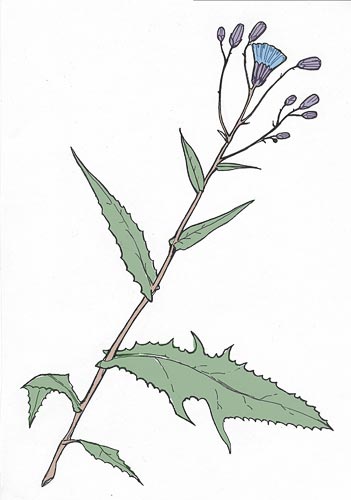Weeds
Lactuca sibirica (L.) Maxim. - Siberian Lettuce.
Systematic position.
Family Asteraceae (Compositae), genus Lactuca L.Synonyms.
Lactuca sibirica (L.) Benth., Lagedium sibiricum (L.) Sojak., Sonchus sibiricus L., Mulgedium sibiricum Less., Agathyrsus sibiricus D.Don.Biological group.
Perennial rhizome plant.Morphology and biology.
Stalks are 25-100 (to 140) cm in height, straight, simple, non-pubescent, frequently red. The main root is erect, sometimes branchy. The root system consists of numerous roots and rhizomes. Leaves are sessile, lanceolate, elongate-acuminate, 1-5 cm in width, 6-18 cm in length, full, less often runcinate or pinnatilobate. Leaves are naked or weakly pubescent, amplexicaul cordate or sagittate at base; upper side green, underside glaucous. Phyllotaxy alternate. Corymbose-paniculate inflorescence consists of rather large calathidia 2.5-3 cm in diameter. Flowers are dark blue or violet, with ligules. Ligules are 10-15 mm in length and 2-3-mm in width. Involucre is cylindrical in form, 3-4-seriate, 9-14 mm in length, 4-8 mm in width. Leaflets lanceolate, bare with the pubescent top. Fruits are hemicarps, slightly compressed and ribbed, up to 5 mm in length, densely pubescent. Rostellum is usually a quarter the size of the hemicarp. Pappus is yellowish, up to 10 mm in length.Distribution.
Lactuca sibirica is a boreal species. In the former USSR, it is distributed throughout the Northern European region, Siberia and the Far East. General distribution of the species includes Scandinavia, northern areas of Mongolia and China, Japan and North America.Ecology.
Lactuca sibirica grows in damp forests and meadows, as well as along river and rivulet shores. It occasionally grows in forest-tundra and forest-steppe zones. It is frequently found in ruderal places, rarely among crops.Economic significance.
The species is seldom found in crops. The unique, recent reference to it as a weed occurs in V.V. Nikitin.s .Weeds of flora of the USSR. (1983), which identifies the species as a crop weed in northern areas of the USSR and in the Russian Far East. There are no published data on the harmfulness of Lactuca sibirica. The species may be considered a potential weed only.Related references:
Cherepanov S.K. 1995. Vascular plants of Russia and adjacent states (of the former USSR). Saint-Petersburg: Mir i semja-95. 991 pp. (in Russian).Kharkevich S.S., ed. 1992. Vascular plants of the Soviet Far East. Saint Petersburg: Nauka. Vol. 6. 428 pp. (in Russian).
Krasnoborov I.M., ed. 1997. Flora of Siberia. Novosibirsk: Nauka. Vol. 13. 472 pp. (in Russian).
Nikitin V.V. 1983. Weed plants of the USSR flora. Leningrad: Nauka. 454 pp. (in Russian).
Ulyanova T.N. 1998. Weed plants in flora of Russia and other CIS countries. Saint Petersburg: VIR. 233 pp. (in Russian).


